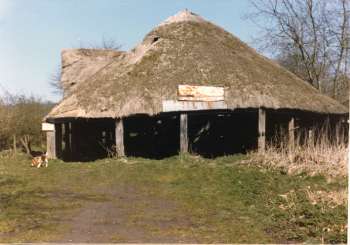 |
|
11th
April 1977
|
|
Gunton Sawmill
Hagon Beck |
 |
|
11th
April 1977
|
|
Gunton sawmill was built in the 1820s and in 2008, is unique amongst surviving
mills in Norfolk. Its construction was simple and consisting of a timber
framework that was open on three sides, with a hipped thatched roof of Norfolk
Reed. The mill was built to take its water power from Sawmill Lake. The lake surface
being set well above the mill provided a 16 foot head of water that powered
two identical 12 foot diameter by 5 feet wide breastshot wheels via a
guillotine gate. The left hand wheel powered the main 6' 6" flywheel driven reciprocating frame saw and the right hand wheel was set to drive a circular saw and ancilliary equipment including a small corn mill. |
While the mill was being built Lord Suffield instructed that an armed guard remained on site to discourage workers from destroying the building due to their fear of being put out of work. |
Gunton had a mill listed at the time of Domesday that would have been a corn watermill. |
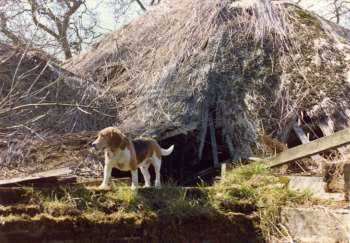
|
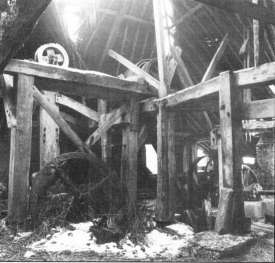 |
The roof 11th April 1977 |
Machinery before restoration in the 1970s |
|
Sawmill Lake is linked to the larger lake known as Great Water, which is in turn fed by Hagon Beck. The mill tailrace joins Suffield Beck, which becomes the Blackwater before joining the River Bure. Both the lakes are artificial and were probably created shortly after the hall was built in 1742. The Great Water was created simply by damming Hagon Beck. Saw Mill Lake was once known as Old Farm House Pond and before that Park Gate Water. Its position was chosen purely to enhance the view from Gunton Hall and meant that considerable earthworks were required to retain the water. |
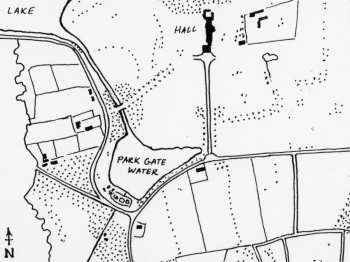 |
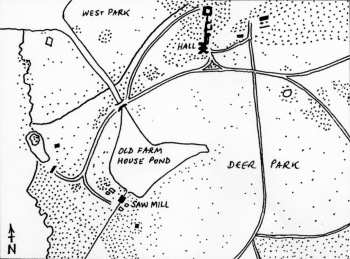 |
Estate map 1784 showing stew ponds |
Estate map 1835 now with sawmill and new road to the Hall |
| Two
Norwich School artists painted Gunton park and debatably Gunton sawmill: John Sell Cotman, watercolour, 1822, Entrance to Gunton Park - property of Birmingham City Art Gallery John Middleton, oil on canvas, 1849, Gunton Park - property of Norwich Castle Museum Art Gallery |
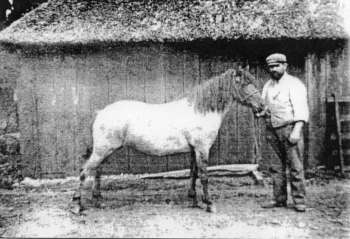 |
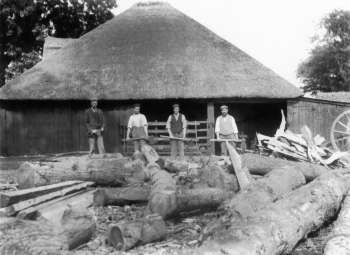
|
John Ward, head sawyer c.1900 |
Sawmill workers c.1900 |
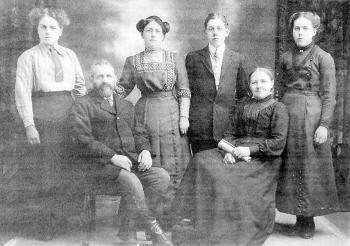 |
|
John
Henry Ward and family c.1914
|
John
Henry Ward, head sawyer and his second wife Anna Maria, with their family pose for a photograph thought to have been taken on the occasion of their son, Charles joining the army. Left to right standing: Maude Elizabeth Ward, Maria (Mary) Ward, Charles Henry Ward, Alice Mary Ward. Charles Henry Ward joined the London & Scottish Regiment and was killed in northern France on 29th October 1916. |
During
the second world war the firm of Longhurst (based in Epsom) was contracted
to process timber for the war effort. The main products produced were pit
props as these could no longer be imported from Scandinavia and Russia.
The lake could not support full time working of the sawmill, which was only built to supply the estate. After two days of continual working the level of the lake would have dropped dramatically. As a result Longhurst installed a bandsaw and circular saw outside the mill run by a steam engine. One night during the war years there was a fire that damaged the thatch and some of the roof timbers. There has been some speculation as to the cause of the fire; either an RAF driver was refuelling his vehicle with a lighted cigarette in his mouth or a spark from the ignition system ignited the fuel in a parked timber lorry. |
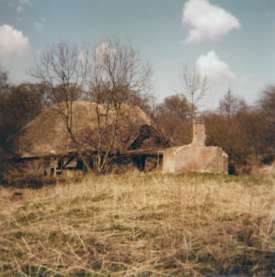 |
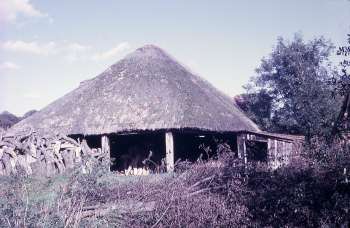 |
Mill and outhouse in 1977 |
October 1967 |
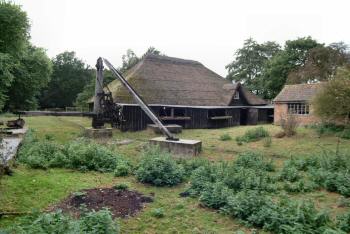 |
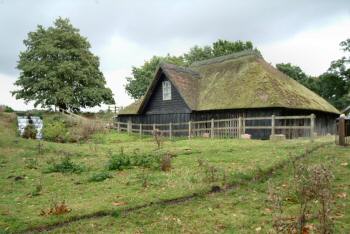 |
|
Mill and outhouse in 2003
|
28th
September 2003 |
During
the early 1960s an old tunnel under the lake managed to unblock itself with
the result that the whole lake started to empty. A whirlpool appeared about
30 yards out as water poured out flooding a large area below the lake including
the interior of the mill. It was three days before anything was done, eventually
14 sacks were filled with sawdust from the mill and taken out into the lake
by rowing boat. This was followed by buckets of earth until the hole was
finally blocked once more by the Monday evening. |
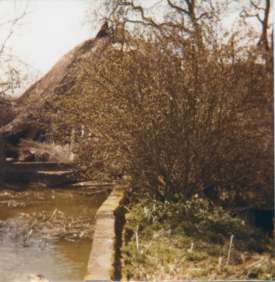 |
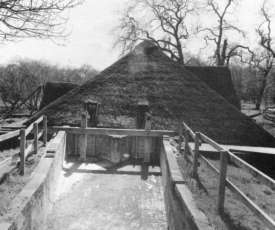 |
|
Mill leat in 1977
|
Mill
leat c.1990 |
|
The mill leat is the artificial channel that feeds water from the water source to the waterwheel. The leat at Gunton is made of rendered brickwork. The leat inlet is controlled by a sluice and wheel shuts are smaller sluices that allow water to be fed to the wheels. |
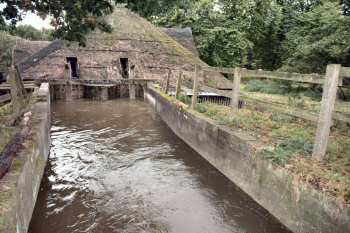 |
|
Mill
leat 28th September 2003
|
| By the early 1970s the centre oak upright posts had sunk into the floor leaving a good 6" gap at the top. |
|
The mill ceased working in the 1950s and over the years became derelict. In 1976 it was decided to demolish the mill and the grist mill machinery was offered to the Norfolk Museum Service, thereby alerting the Norfolk Industrial Archaeology Society (NIAS). In 1979 The Norfolk Windmills Trust purchased the lease and in partnership with NIAS, proceeded to restore the mill. (See links page) The fully restored building is now open to the public on several occasions throughout the year and the dates are well publicised in the local press. |
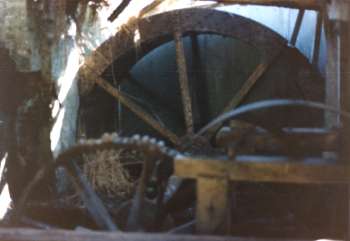 |
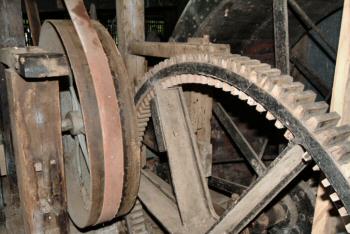 |
|
Waterwheel and pitwheel 11th April 1977
|
Recogged
pitwheel and waterwheel behind September 2003 |
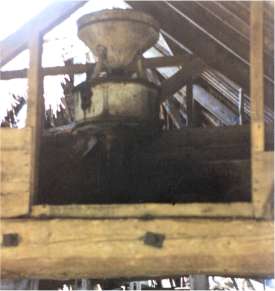 |
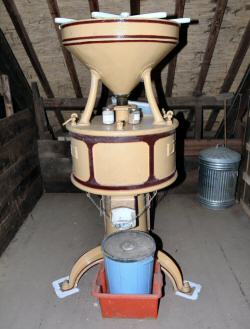 |
|
The cornmill 11th April 1977
|
The
cornmill 28th September 2003 |
|
The small flour mill was made by Ransomes & Sims of Ipswich in 1868 and cost £60. The cast iron casing contained two 2' 6" French burr stones. The upper stone was in fact the bedstone, leaving the lower stone as the runner, which was adjustable to accommodate either grinding for flour or crushing for animal feed. It was said to have been used to grind flour for the Hon. Doris Harbord for many years and was last used in 1952. |
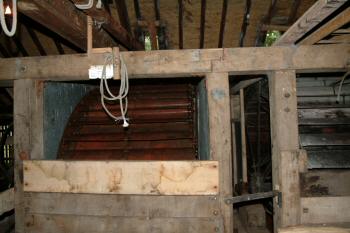 |
|
The
two waterwheels 28th September 2003
|
|
Holmes &
Son of Norwich replaced the original much repaired wooden waterwheels
with two iron waterwheels in 1888 at a cost of £164. The wheels
were never connected together and always worked different machinery. |
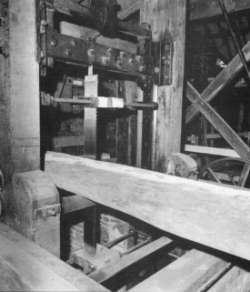 |
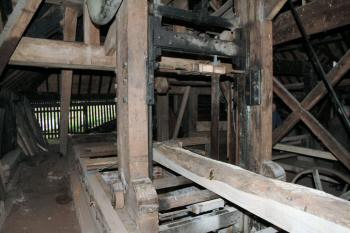 |
The frame saw in 1991 |
The frame saw 28th September 2003 |
|
The mill contained
two types of saw, a frame saw and a circular saw. The frame saw moved
up and down in a similar fashion to a two man pit saw and was capable
of planking trees 2½ feet wide and up to 20 feet long. The Holmes
(of Norwich) circular saw was also a ripsaw and worked in conjunction
with the frame saw, cutting smaller timbers, whilst all cross cutting
was done by hand. The Holmes saw was thrown out during the second world
wart to make way for vehicle parking. Some 70% of it survived intact and
the remainder has since been made up. |
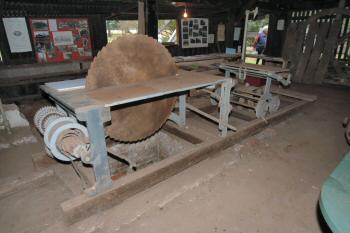 |
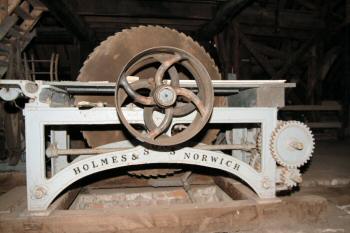 |
|
The
circular saw rig 28th September 2003
|
The
circular saw bench 28th September 2003 |
|
The up-and-down saw is a unique survivor, the only
working example in the UK - there are only a few left in the world. It
has more ironwork in its construction than usual, because Hase ran an
iron foundry and was a self taught engineer. It was an estate tool, so
free of commercial pressures. The estate was proudly self sufficient.
A skill born of experience was needed to work it and was passed from one
sawyer to the next for around 90 years. We suspect that the First War
broke that pattern and after it the incentive to relearn was absent. The
machinery was rickety, contractors were available and it was scarcely
used. Memories from old men who played around the mill as kids gave contradictory
accounts. Probably occasionally the sawyers tried; perhaps they were put
off by the absence of any fence to guide the log. It is remarkable that
so much survived but there was sufficient for the wood to be measured
and replaced like-for-like and the iron to be cleaned and repainted. |
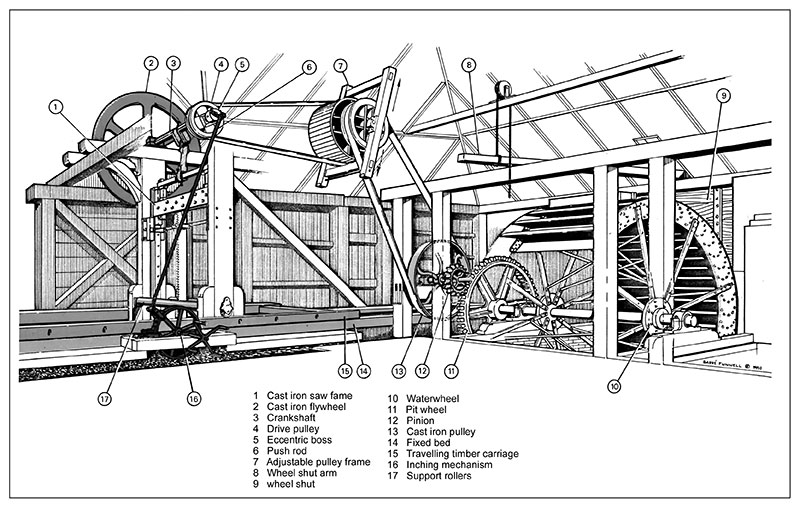 |
|
Diagram of sawmill workings by Barré Funnell
|
|
The original corn_watermill was situated below the Great Water (Park Gate Water not having been constructed then). The outlet from Great Water would have crossed the road as it approached the Gatehouse and the mill stood close to the road at that point. However, the mill would have become ruined when Lord Suffield built his ornamental lake and starved the old mill of a water supply. |
|
Gunton Park
Sawmill has been open to the public for demonstration working on the fourth
Sunday afternoon of each month between April and September since 1988,
manned by a team of skilled volunteers. Norfolk Windmills Trust and NIAS
would be pleased to welcome any additional help. |
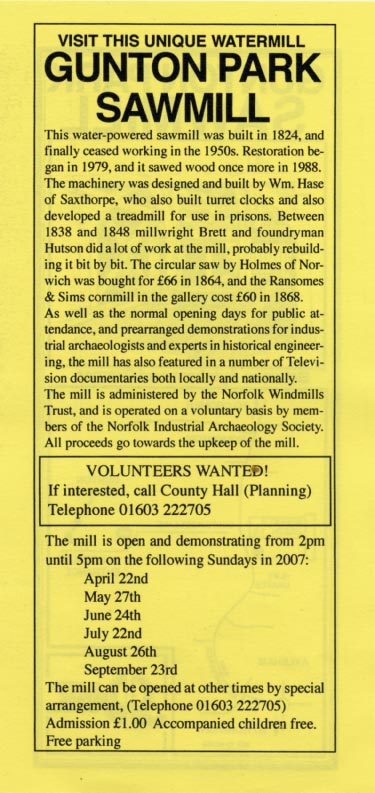 |
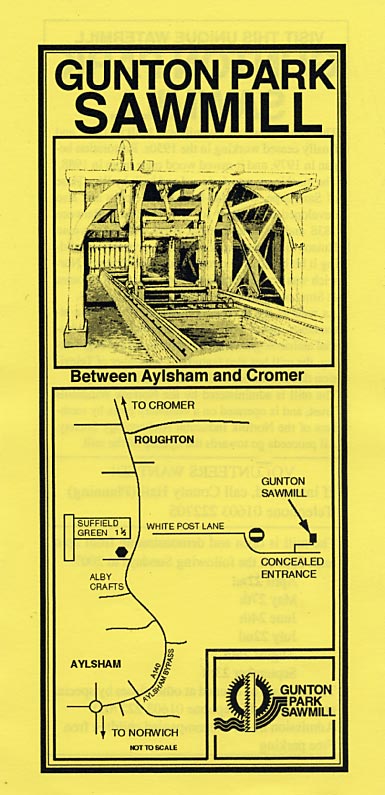 |
2007 leaflet |
|
I was born in Suffield 46 years ago and I grew up spending many hours with
my friends playing "on the Park".
|
Lottery windfall saves historic Norfolk sawmill from closure |
An historic sawmill that is one of the hidden treasures of north Norfolk will be given another 30 years of life - thanks to a lottery windfall. Gunton Sawmill was thought to be two years from closing to the public because its bedraggled thatch is allowing water to drip on the machinery, which dates from the 19th century. But a chance meeting at the Norfolk Record Office led to a successful bid for £69,000 from the National Lottery, which will repair the thatch and enable volunteers to make the facility more visitor friendly. Volunteer Russell Yeomans said: "There was an exhibition about Gunton at the Norfolk Record Office and David Doak and I went along. "We were talking to the organiser and he pointed us in the direction of a chap who was an east of England lottery fund manager. "We bent his ear about the problems with the mill and he suggested we put in an application." He added: "We were absolutely delighted to hear that we had been successful. Of the £69,000, £45,000 will be used to thatch the roof. We will repaint the outside and re-render the mill race where the water comes in. "We are also getting matting to improve disabled access." Mr Yeomans said the volunteers - who opened the sawmill to the public occasionally throughout the year - wanted to "make it more accessible and open it up to specialist groups". The mill was built in the 1820s and is unique amongst surviving mills in Norfolk. It was built to take its water power from Sawmill Lake, and was designed to provide sawn timber for the 12,000-acre Gunton Hall estate, although it also has a small grist mill set on the beams within the roof area. A small brick outhouse stands beside the mill, which was used as a smithy, a rest area and a workshop. Mr Yeomans said: "We were ecstatic about the money. We rely on Norfolk County Council for funding, but they are cutting back. We could see it being closed. Without this money, we were looking at that happening in a couple of years as the machinery won't take water dripping on it." Steve Downs, Eastern Daily Press - 17th April 2013 |
I have been keeping old news cuttings about the mill mainly because my wife got herself involved in this craze of chasing up her family tree and she made me do a little searching of my own. Your portrait of the head sawyer John Henry Ward and his family in the North Norfolk news May 2 2013 is my Grandfather. My name is John Anthony Ward and I have two sons James & Timothy. |
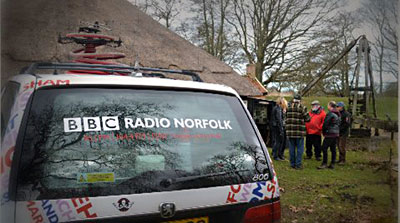 |
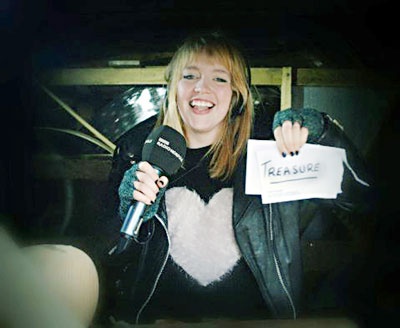 |
Radio Norfolk radio car 1st March 2015 |
Sophie Little finding the treasure 1st March 2015 |
Radio Norfolk's Sunday morning Treasure Quest ended at the mill on Sunday 1st March 2015, where clue solver Sophie Little found the treaure under a plane on the carpenter's bench with nine minutes to spare. |
Norfolk's Gunton mill to be shut down for safety assessment |
It is one of Norfolk's most idiosyncratic attractions, sitting in a building that looks like a Hobbit house. Since 1989, volunteers have been operating the 200-year-old water-powered sawmill at Gunton, between Aylsham and Cromer in north Norfolk, allowing visitors to see history come to life. But now there are concerns for the future of the mill, after Norfolk County Council told volunteers to "temporarily" stop operating the machinery. The mill is privately owned, leased by the county council and managed by the Norfolk Windmill Trust. It uses nothing but the power of water to turn the mill wheels and drive the serrated saw up and down. On open days, volunteers run and explain the machinery for tourists and private groups. A county council spokesperson said: “We have asked the volunteers who operate the mill to temporarily stop using the saw until an updated safety assessment is carried out. "Regular risk assessments are necessary to ensure that both volunteers and visitors continue to remain safe at all times. "We are keen to closely work with the volunteers to carry out the review as soon as possible so that the saw can reopen quickly. "In the meantime, other activities that don’t use the saw can continue as normal," the spokesperson added. But Russell Yeomans, volunteer, said the matter has been "handled really badly". "The council has stopped us running it. But if we're not running it, there's nothing for people to see. "The timing was really bad. Their attitude to the welfare of the volunteers isn't good at all. "They don't give a monkey's about the welfare of the people running it. "It is very much a working museum, the only one of its kind in the country, but they've basically ripped the heart out of it," he added. Mr Yeomans, who has worked at the mill for 17 years, said he is leaving his position on account of the way the matter has been handled. "I don't know if it will ever open up again," he said. According to the mill's website, as of Tuesday, June 18, the open days planned for the rest of this year include June 23, July 28, August 25 and September 22. History of the Mill The sawmill, a timber and thatch structure that houses a frame saw and early circular saw, was built in 1824. Its purpose was to take its water power from Sawmill Lake, and it was designed to provide sawn timber for the 12,000-acre Gunton Hall estate. It also has a small grist mill set on the beams within the roof area. A small brick outhouse stands beside the mill, which was used as a smithy, a rest area and a workshop. The mill went into decline after the First World War, and finally ceased working in the 1950s. But its re-discovery in 1976 by Norfolk Windmills Trust triggered a 12-year labour of love by volunteers. In 1979, the last remaining member of the Harbord family agreed to lease the site and duly signed a 999-year lease to the Norfolk Windmill's Trust who would oversee the restoration. And in 1988, it was finally possible to use the saw to cut timber using the power of flowing water. The first public opening took place in 1989. Twenty-four years on, the sawmill was again in danger of falling into disrepair, largely because of a leaky thatched roof that was allowing water to damage the machinery. In 2013, the roof thatch was replaced, thanks to a grant from Heritage Lottery Fund, and repairs to the millrace were completed. The mill is managed by Norfolk Windmills Trust and is operated by volunteers. It is a Grade II* listed building. Daniel Hickey, North Norfolk News - 19th June 2024 |
Gunton sawmill remains closed despite further assessment |
A meeting is due to take place about the future of a historic sawmill after volunteers were told it was unsafe to operate its main machinery. |
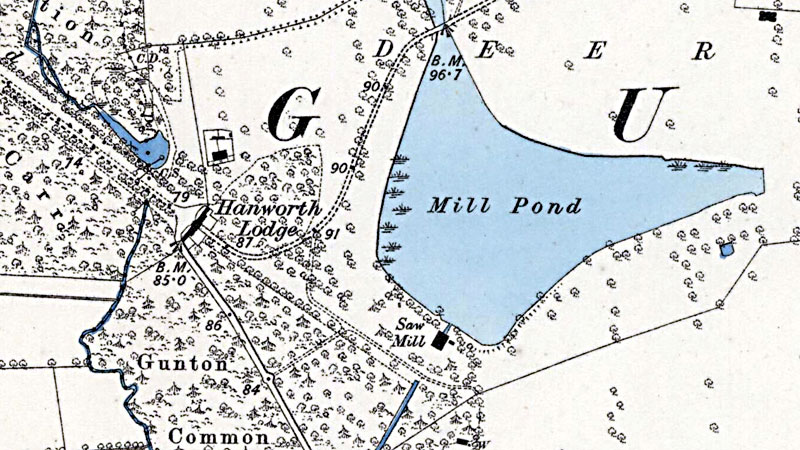 |
O. S. Map 1885 |
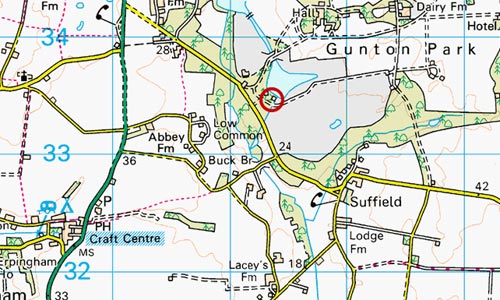 |
O.S. Map 2005 Image reproduced under licence from Ordnance Survey |
|
Gunton Park Sawmill has been open to the public for demonstration working on the fourth Sunday afternoon of each month between April and September since 1988, manned by a team of skilled volunteers. Norfolk Windmills Trust and NIAS would be pleased to welcome any additional help. |
|
c.1750: Artificial lake formed
Estate ledgers 1858: New waterwheel £59
c.1899: Estate carpenters' shop moved from general yard to extension built on the side of the sawmill |
If you have any memories, anecdotes or photos please let us know and we may be able to use them to update the site. By all means telephone 07836 675369 or
|
| Nat Grid Ref TG22363346 | Copyright © Jonathan Neville 2003 |